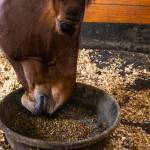Liver Health in Horses: Dietary Fat and Exercise

How many of the following statements are true?
- Horses can easily digest fat although they don’t have gall bladders.
- All grazing horses ingest a certain amount of fat every day.
- Providing more calories from fat and fewer from hydrolyzable carbohydrates can ease muscle problems in some horses.
It might surprise some horse owners to learn that all of these statements are true.
According to equine nutritionist Kathleen Crandell, Ph.D., horses are able to digest fat, a small amount of which is found in grass, without the help of a gall bladder. In humans, the gall bladder stores bile and excretes it as required to help emulsify fats after a meal is eaten. In horses, bile is produced by the liver, and small amounts are sent directly into the intestine rather than being stored until needed. This is one reason that horses must be introduced gradually to a feed with a higher level of fat. Because only a small amount of bile is present, a meal rich in fat can’t be digested efficiently and the horse may develop diarrhea. If the amount of dietary fat is increased a little at a time, the horse’s digestive system adapts to the change.
In some horses, metabolism of carbohydrates contributes to severe muscle cramping during exercise. Switching to a diet with a lower percentage of starch and a greater percentage of fat relieves muscle problems in many horses. Several causes of tying-up syndromes have been identified, not all of which are caused by the ingestion of hydrolyzable carbohydrates, so horses that experience muscle cramping during or after exercise should be examined by a veterinarian to determine the exact problem and suggest the most effective treatment.
Kentucky Equine Research pioneered the first low-starch, high-fat feed products designed to reduce the incidence of nutrition-related muscle problems in exercising horses, including RE•LEVE®*. For horses that are being asked to work hard on a regular basis, a high-fat, high-fiber feed will likely be a necessary part of the diet. As fat levels rise in a feed, starch levels usually drop. This is the case when feed ingredients include a large percentage of soy hulls and beet pulp. Other low-starch, low-sugar feedstuffs include alfalfa-based (lucerne-based) products such as pellets and cubes, complete feeds intended to replace hay, and chopped-hay products.
In addition to producing bile for fat digestion, the liver has a number of other important functions in horses. It produces hormones that affect immune function, blood pressure, and red cell production; forms glucose and stores this energy source as glycogen; and serves as a repository for a number of fat-soluble vitamins. The liver can also neutralize many harmful substances, but it can be damaged if the horse eats certain toxic plants.
*While RE-LEVE is not available in Australia and New Zealand, Kentucky Equine Research has numerous high-fat, high-fiber feed options available in these areas. Please contact KER Australia for more information.








